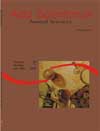<b>Total non-structural carbohydrates contents of Tanzania grass fertilized with different levels of nitrogen</b> - DOI: 10.4025/actascianimsci.v27i4.1144
Abstract
The experiment was conducted under greenhouse conditions, in Jaboticabal, state of São Paulo, Brazil, to evaluate the contents of total non-structural carbohydrates (TNC) of Tanzania grass, submitted to five levels of N (0, 75, 150, 225 and 300 mg.dm-3 of soil) and evaluated at four periods (20, 30, 40 and 50 days after emergence). The experimental design consisted of a completely randomized block with three replications, in a factorial arrangement of 5 x 4. The plants were cut at soil level and the aerial part of plants were separated from the root system. Contents of starch, soluble carbohydrates (SC) and TNC were evaluated in the aerial part and root system. At the stem basis the contents of starch, SC and TNC increased according to period nitrogen doses and root systemDownloads
Download data is not yet available.
Published
2008-03-14
How to Cite
Pedroso Vantini, P., de Jesus Deléo Rodrigues, T., Pessoa da Cruz, M. C., de Andrade Rodrigues, L. R., & Malheiros, E. B. (2008). <b>Total non-structural carbohydrates contents of Tanzania grass fertilized with different levels of nitrogen</b> - DOI: 10.4025/actascianimsci.v27i4.1144. Acta Scientiarum. Animal Sciences, 27(4), 425-432. https://doi.org/10.4025/actascianimsci.v27i4.1144
Issue
Section
Pasture and forage utilization
DECLARATION OF ORIGINALITY AND COPYRIGHTS
- I Declare that current article is original and has not been submitted for publication, in part or in whole, to any other national or international journal.
The copyrights belong exclusively to the authors. Published content is licensed under Creative Commons Attribution 4.0 (CC BY 4.0) guidelines, which allows sharing (copy and distribution of the material in any medium or format) and adaptation (remix, transform, and build upon the material) for any purpose, even commercially, under the terms of attribution.
Read this link for further information on how to use CC BY 4.0 properly.
0.9
2019CiteScore
29th percentile
Powered by 








































